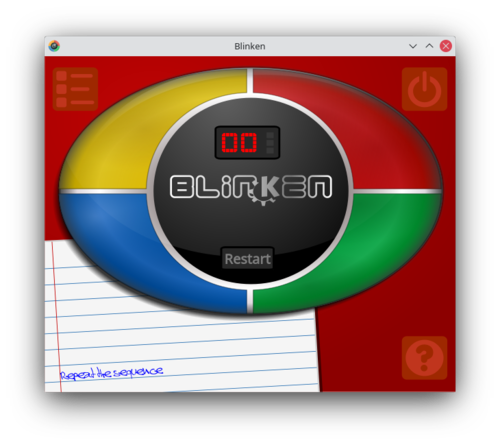BlinKen/da: Difference between revisions
(Importing a new version from external source) |
(Importing a new version from external source) |
||
| Line 14: | Line 14: | ||
==Beskrivelse== | ==Beskrivelse== | ||
'''Blinken''' | '''Blinken''' er baseret på et elektronisk spil udgivet i 1978, som udfordrede spillerne til at huske stadigt længere sekvenser. | ||
On the face of the device, there are 4 different color buttons, each one with their own distinctive sound. These buttons light up randomly, creating the sequence that the player must then recall. If the player is successful in remembering the sequence of lights in the correct order, they advance to the next stage, where an identical sequence with one extra step is presented. If they are incorrect, the game is lost, and the player must start again from the beginning. | On the face of the device, there are 4 different color buttons, each one with their own distinctive sound. These buttons light up randomly, creating the sequence that the player must then recall. If the player is successful in remembering the sequence of lights in the correct order, they advance to the next stage, where an identical sequence with one extra step is presented. If they are incorrect, the game is lost, and the player must start again from the beginning. | ||
Revision as of 15:06, 4 October 2010
Hjem » Programmer » Uddannelse » [[Special:myLanguage/{{{1}}}|{{{1}}}]]

|
Blinken er vores version af det velkendte spil Simon Says.
Det er en del af KDE Education Project. |

Beskrivelse
Blinken er baseret på et elektronisk spil udgivet i 1978, som udfordrede spillerne til at huske stadigt længere sekvenser.
On the face of the device, there are 4 different color buttons, each one with their own distinctive sound. These buttons light up randomly, creating the sequence that the player must then recall. If the player is successful in remembering the sequence of lights in the correct order, they advance to the next stage, where an identical sequence with one extra step is presented. If they are incorrect, the game is lost, and the player must start again from the beginning.
The goal is to get a high score - each step in the sequence is worth one point, so correct entry of a sequence of 8 lights is worth 8 points on the high score table.
